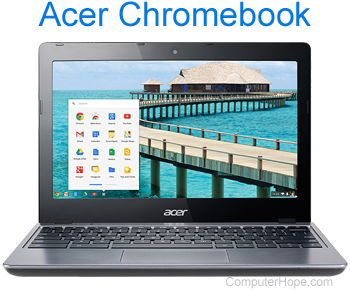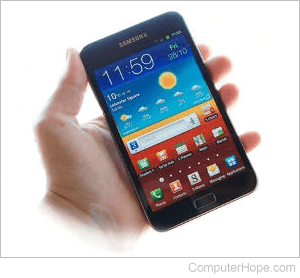Computer history - 2011
Major computer events in 2011

The first Chromebooks with ChromeOS began shipping on June 15, 2011.
2011 computer and technology top terms
The following are some top computer and technology-related terms in alphabetical order that were introduced or popularized during 2011.
New computer products and services introduced in 2011
Intel released a small form factor computer called NUC (Next Unit of Computing).
Intel released seven new Core i5 processors with four cores, the i5-2xxx series (6 M cache, 2.3 GHz to 3.3 GHz) in January 2011.
Intel Sandy Bridge processor was released on January 9, 2011.
Windows Embedded Handheld was announced in January 2011.
The macOS App Store was launched on January 6, 2011.
The MMORPG (massively-multiplayer online role-playing game) TERA (The Exiled Realm of Arborea) was released in South Korea on January 25, 2011.
The first stable version of LibreOffice was released on January 25, 2011.
The software known as Hudson was released on February 2, 2011, but because of a trademark dispute with Oracle later changed its name to Jenkins.
The ManageFlitter service for Twitter was launched in February 2011.
Android version 3.0 (Honeycomb) was released on February 22, 2011.
Apple released the Thunderbolt hardware interface on February 24, 2011.
Gaikai launched on February 27, 2011. The service became known as PlayStation Now.
WebGL was released in March by the Mozilla Foundation.
The MMORPG Rift was launched in North America on March 1, 2011.
Gnash 0.8.9 was made available on March 20, 2011.
In March 2011, an iPhone app for Pinterest was introduced.
Microsoft released Internet Explorer 9 on March 14, 2011.
BlackBerry released the BlackBerry Tablet OS for the PlayBook in April 2011.
On April 17, 2011, Sony began to notice an attack that they later disclosed as having compromised around 77 million PlayStation accounts.
BlackBerry released the PlayBook on April 19, 2011.
The first motherboards began including USB (universal serial bus) 3.0 ports in April 2011.
WeVideo was introduced in April 2011.
In April 2011, VMware entered the cloud computing market by releasing Cloud Foundry, an open source platform-as-a-service software system.
Android version 3.1 was released on May 10, 2011.
Picaboo, which became Snapchat, was launched in June 2011.
AMD released the first mobile processors in its A4 line, the A4-3300M and the A4-3310MX, on June 14, 2011.
AMD released the first mobile processors in its A6 line, the A6-3400M and the A6-3410MX, on June 14, 2011.
AMD released the first mobile processors in its A8 line, the A8-3500M, the A8-3510MX, and the A8-3530MX, on June 14, 2011.
Google Takeout was created on June 28, 2011.
Final Cut Pro was released by Macromedia on June 21, 2011.
Microsoft introduced Office 365 on June 28, 2011.
AMD released the first desktop processor in its A6 line, the A6-3650 (4 M L2 cache, 2.6 GHz, 1866 MHz FSB), on June 30, 2011.
AMD released the first desktop processor in its A8 line, the A8-3850 (4 M L2 cache, 2.9 GHz, 1866 MHz FSB), on June 30, 2011.
Microsoft released a Windows SDK (software development kit) package for Kinect in June 2011.
The macOS 10.7.3 (Lion) was released on July 20, 2011. New features included AirDrop, Gatekeeper, and many more.
Android version 3.2 was released on July 15, 2011.
The first version of Snowlinux was released in August 2011.

Netflix introduced its online video streaming in September 2011. The service allows users to stream movies and TV shows over the Internet.
AMD released the first desktop processors in its A4 line, the A4-3300 and the A4-3400 on September 7, 2011.
Litecoin, a cryptocurrency, was released on October 7, 2011.
Minecraft game was released for Android OS (operating system) devices.
UltraViolet service was introduced on October 11, 2011.
Adobe announced Creative Cloud in October 2011.
Android version 4.0 (ice cream sandwich) was released on October 8, 2011, introducing Android Beam.
Apple introduced the iPhone 4s on October 14, 2011. With this introduction, Apple also introduced FaceTime.

Samsung released the Galaxy Note smartphone in October 2011, and the term phablet became a new way of describing larger phones.
The Kindle Fire was released for sale on November 15, 2011.
The Amazon Silk Internet browser, developed for Fire OS devices, was released on November 15, 2011.
Google released Google Play Music on November 16, 2011.
Bootstrap was developed in 2011 by a team at Twitter led by Mark Otto and Jacob Thornton.
C++ version 11 was released in 2011.
Duolingo was released in 2011.
Kotlin began development in 2011.
Livescript was introduced in 2011.
MATE was released in 2011.
Microsoft released Excel 2011 for Mac in 2011.
The ITU (International Telecommunication Union) updated ITU-T Z.120 in February 2011, breathing new life into MSC (message sequence chart).
Oracle Fusion was released in 2011.
The PlayStation Vita was released and replaced the PlayStation Portable in 2011.
Cave Story+ was released on the Steam platform in 2011.
In 2011, the MacBook Pro was the first of Apple's computers to utilize its proprietary Thunderbolt port.
The magicJack Plus was introduced and released in 2011. It requires an Internet connection, but does not require a computer.
Samsung released the Galaxy S II in 2011.
Dell released the XPS 8300 and XPS 14 in 2011.
Computer and technology-related events in 2011
Any CompTIA certifications done before January 1, 2011, are considered GFL (good-for-life) and do not expire. However, anyone taking future tests from this point would need to renew their certification every three years.
On January 6, 2011, Aaron Swartz was arrested by federal authorities in connection with using MIT's network to download nearly five million academic journal articles from JSTOR.
Watson, an IBM supercomputer, beat the two best human Jeopardy players in a three-day event with a score greater than the two human players combined on February 16, 2011.
In January 2011, Singlestore was founded.
The Silk Road came online in February 2011.
Oracle renamed StarOffice to Oracle OpenOffice and later handed over all ownership and trademarks to the Apache foundation.
The United States government held a hackathon in 2011 to improve city transit systems.
Microsoft announced plans on May 10, 2011, to acquire Skype for $8.5 billion in cash.
BitMinter was released on June 26, 2011.
Google+ was made available for invite only on June 28, 2011.
The typing game Nitro Type launched on September 8, 2011.
Stripe was officially launched on September 29, 2011.
Google introduced the Dart programming language in October 2011.
Facebook replaced the Facebook Wall with the new Facebook Timeline in December 2011.
Li-Fi technology was introduced by Harald Haas during a TEDGlobal conference in Edinburgh, Scotland, in 2011.
Ultrabook, a new thinner version of laptop computers, began being released.
Intel introduced the Xeon Phi processor.
Friendster rebranded to a social gaming site in 2011.
Facebook replaced the Facebook Wall with the new Facebook Timeline in December 2011.
The EverQuest games were converted to free-to-play games (with microtransactions) in November 2011.
Emojis became more mainstream after introduced on the iPhone in 2011.
Nokia moved the Symbian source under the proprietary Nokia Symbian License in 2011.
The Egyptian government shut down Internet access several times during the 2011 protests to prevent any information from leaking out onto the Internet.
Wolfram Alpha adopted "hella" as a scientific prefix in 2011 to help describe a hellabyte.
In 2011, Kubuntu was chosen as the operating system to be installed on half a million primary and secondary schools in Brazil.
Computer companies and organizations founded in 2011
Fullscreen, Inc. was founded in January 2011.
The founders of Justin.tv launched the gaming site Twitch on June 6, 2011.
BitPay was founded in 2011.
Codecademy was founded in 2011 by Ryan Bubinski and Zack Sims.
Databox was founded in 2011.
DigitalOcean was founded in 2011.
Netlux was founded in 2011.
PCPartPicker was founded in 2011.
Powtoon was founded in 2011.
Powtoon was introduced in 2011.
Shotcut was introduced in 2011.
Snap Inc. was founded in 2011.
Teespring was founded in 2011.
Trello was founded in 2011.
THQ Nordic was founded in 2011.
Udacity was introduced in June 2011 by David Stavens and Sebastian Thrun.
Computer company events in 2011
EIA (Electronic Industries Alliance) officially ceased all operations on February 11, 2011.
On February 21, 2011, CSR announced it would merge with Zoran.
Hitachi sold its hard drive division to Western Digital in March 2011.
GoPro acquired CineForm on March 30, 2011.
On June 29, 2011, Newscorp sold MySpace to Specific Media Group for $35 million, around $473 million less than Newscorp paid.
HTC purchased the majority shares of S3 Graphics from VIA Technologies on July 6, 2011, to acquire S3 Graphics and its patents.
On August 18, 2011, Hewlett-Packard announced an interest in selling its Personal Systems Group, including WebOS.
Apple overtook Exxon to become the world's most valuable company on August 10, 2011.
Google announced it would acquire Motorola Mobility for $12.5 billion on August 15, 2011.
Steve Jobs resigned as Apple's CEO due to health reasons on August 24, 2011.
Qwest began doing business as CenturyLink in August 2011.
SAP (System Analysis and Program) acquired 3-D visualization software maker Right Hemisphere on September 6, 2011.
National Semiconductor became part of Texas Instruments on September 24, 2011.
TeleVideo discontinued the manufacturing and sales of all terminal products on September 30, 2011.
On October 3, 2011, Rhapsody announced it would acquire Napster, which was completed later that year.
The A+ certification changed from a lifetime certification to a certification that needs to be renewed every three years.
Data Robotics changed its name to Drobo, Inc. in 2011 after the popularity of its Drobo product.
Medion became part of Lenovo in 2011.
TechCrunch began hosting the annual technology conference, TechCrunch Disrupt, in 2011.
Twitter acquired Whisper Systems in 2011.
In April 2011, Xinuos acquired the assets, including SCO UNIX and SCO OpenServer, from bankrupt SCO.
Zoom Video Communications was founded in 2011 by Eric Yuan.
Discontinued products and services in 2011
On April 12, 2011, Cisco announced it "will exit aspects of its consumer business," which included shutting down Pure Digital Technologies Flip.
On July 1, 2011, Columbia University announced the Kermit project was canceled. All future development of C-Kermit, E-Kermit, and Kermit 95 is now handled through the Kermit Project.
Google ended Google Labs in July 2011.
Google Buzz was discontinued on December 15, 2011, and replaced by Google+.
Microsoft Zune products were discontinued in 2011.
Computer pioneer deaths in 2011

Ken Olsen passed away on February 6, 2011 (Age: 84).
Jean Bartik passed away on March 23, 2011 (Age: 87).
Paul Baran passed away on March 26, 2011 (Age: 84).
Sidney Harman passed away on April 12, 2011 (Age: 92).
Jack Wolf passed away on May 12, 2011 (Age: 76).
Jeffrey Chu passed away on June 6, 2011 (Age: 91).
Tony Sale passed away on August 28, 2011 (Age: 80).
Michael Hart passed away on September 6, 2011 (Age: 64).
Einar Stefferud passed away on September 22, 2011 (Age: 81).
Steve Jobs passed away on October 5, 2011 (Age: 56).
Dennis Ritchie passed away on October 12, 2011 (Age: 70).
John McCarthy passed away on October 24, 2011 (Age: 84).
